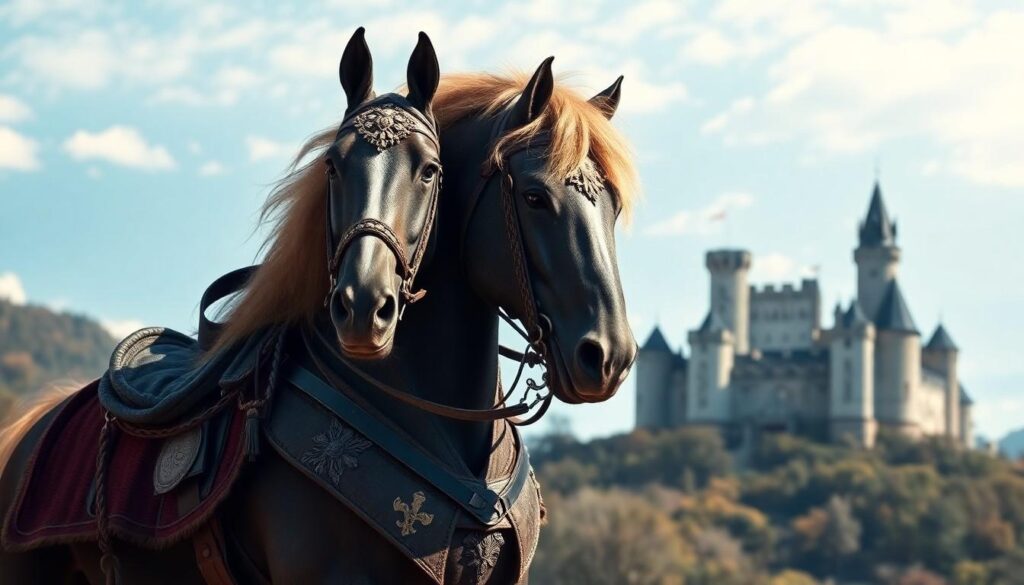Fascinated by the majestic steeds of knights and nobles? We’ve compiled an authentic collection of medieval horse names that capture the spirit of these magnificent animals from the Middle Ages. Whether you’re a history buff, fantasy writer, or simply looking for a unique name for your own equine companion, you’ll find inspiration in these time-honored monikers.
During medieval times, horses weren’t just transportation—they were symbols of power, wealth, and nobility. Knights often named their warhorses after legendary figures, virtues, or characteristics they admired. From the thundering destriers of armored knights to the swift palfreys of noble ladies, each horse held a special place in medieval society and deserved a name worthy of its importance.
10 Majestic Medieval Horse Names Inspired by Legendary War Steeds
- Bucephalus – Alexander the Great’s legendary warhorse was known for its untamable spirit and unique black coat with a white star marking. This name carries the weight of perhaps history’s most famous military partnership, symbolizing loyalty and exceptional battlefield prowess.
- Bayard – The magical steed from French chansons de geste could adjust its size to carry one to four knights simultaneously. Famous for serving Charlemagne’s knights, this name evokes supernatural strength and adaptability, perfect for a horse with remarkable stamina.
- Veillantif – Roland’s mighty charger from the Song of Roland stood faithfully beside the knight through countless battles. This name, meaning “vigilant” or “valiant,” suits a horse with an alert, watchful nature and unwavering courage.
- Llamrei – King Arthur’s trusted mare carried him through many campaigns according to Welsh tradition. This noble name brings Arthurian legend to life and works wonderfully for a graceful yet powerful female horse.
- Favvel – A name drawn from medieval allegorical poetry where it represented cunning and deception. This distinctive name offers a touch of mystique and suits a clever horse with a mischievous personality or unusual coloring.
- Gringolet – Sir Gawain’s renowned steed faced many supernatural challenges alongside his knight. This name carries connotations of endurance and otherworldly adventures, ideal for a horse with exceptional bravery and spirit.
- Marchegai – The valiant warhorse belonging to William of Orange in French epic poetry never tired in battle. This powerful name suggests tireless strength and battlefield stamina, perfect for a robust, energetic horse.
- Arion – The divinely-bred, extremely swift black horse from Greek mythology possessed immortality and human speech. This mythical name suits a horse with exceptional speed, intelligence, or an uncanny connection with its owner.
- Brigador – A name meaning “fighter” or “warrior” in Old French, commonly given to knights’ chargers. This strong, resonant name evokes battlefield glory and matches a bold, confident horse with a commanding presence.
- Morel – The dark-colored warhorse ridden by several legendary knights, including Sir Yvain. This traditional name, referring to the horse’s dark coloring, connects directly to authentic medieval naming practices while honoring famous literary steeds.
Noble Destriers: Powerful Names for Medieval Warhorses

Medieval warhorses, particularly those known as “destriers,” were highly prized for their exceptional strength, agility, and unwavering loyalty on the battlefield. These powerful animals carried knights into combat and often became legendary companions in their own right.
Famous Knights’ Destriers and Their Meanings
Knights frequently gave their warhorses names that reflected their qualities or aspirations. Milan, the trusted steed of Sir Thomas Malory, derived its name likely from the Latin word “Miles” meaning soldier, perfectly capturing its role as a faithful battle companion. Edward the Valiant represented another notable example, with a name suggesting exceptional courage and valor in combat situations. Gringolet, the horse of Arthurian hero Sir Gawain, earned fame for its remarkable speed and endurance during quests and battles. Hengroen, mentioned in ancient Welsh Triads, served as King Arthur’s loyal mount and accompanied him to the fateful battlefield of Camlan. These names weren’t merely labels but embodied the deep bond between knights and their equine partners.
Royal Battlefield Companions
Medieval horses served different purposes based on their build, temperament, and training. Chargers functioned as the primary warhorses, specifically bred for their strength and ability to carry heavily armored knights into battle. Their powerful builds made them ideal for the chaos of medieval combat. Palfreys, while less robust than chargers, provided comfortable transportation for knights and nobles during peaceful times and handled lighter duties. Bucephalus, perhaps history’s most famous warhorse, carried Alexander the Great through many conquests and became a symbol of the unbreakable bond between warrior and steed. Bayard, celebrated in Charlemagne legends, represented the epitome of equine bravery and loyalty, qualities highly valued in medieval warfare. These noble animals weren’t just tools of war but also powerful symbols of wealth, status, and chivalric identity in medieval society.
Chivalric Code: Horse Names Based on Medieval Virtues

Medieval horse names often reflected the virtues most prized in chivalric society, showcasing the values knights aspired to embody through their loyal companions.
Honor and Courage-Inspired Names
Medieval knights frequently named their steeds to reflect qualities of bravery and nobility that were essential to the chivalric code. Bucephalus, the legendary horse of Alexander the Great, stands as perhaps the most renowned example, celebrated for its unmatched speed and strength that symbolized the highest ideals of honor and courage on the battlefield. Warriors throughout history sought to capture similar qualities when naming their own mounts.
Bayard represents another powerful example from French medieval legends, famed as a magical horse of invincibility that embodied the courage and strength all knights aspired to demonstrate in combat. Many medieval texts describe this mythical steed as possessing supernatural abilities that made it undefeatable in battle.
Wellington’s horse Copenhagen earned its place in history during the Battle of Waterloo, where its remarkable endurance and bravery exemplified the courage expected of warhorses. Napoleon’s famous steed Marengo similarly gained recognition for its exceptional courage in battle, carrying the emperor through many military campaigns and becoming a symbol of martial prowess.
Loyalty and Faith-Themed Names
Loyalty and religious devotion formed the foundation of medieval chivalry, inspiring horse names that reflected these sacred virtues. Grani from Norse mythology served as the faithful mount of the hero Sigurd, celebrated throughout medieval tales for its unwavering loyalty and tremendous power. This legendary horse became synonymous with the bond between warrior and steed.
Rocinante, the trusty companion of Don Quixote, represents one of literature’s most famous examples of equine faithfulness. This name became emblematic of the special relationship between a knight and his horse, symbolizing steadfast loyalty even in the face of impossible challenges.
Sir Gawain’s horse Gringolet features prominently in Arthurian legend, known particularly for its exceptional faithfulness to its rider throughout many quests and adventures. Medieval texts describe Gringolet as possessing almost human-like devotion to Gawain during his most perilous journeys.
Brigliadoro, the remarkable horse of Orlando in Italian medieval epics, gained fame for its incredible endurance and unshakable loyalty. Tales recount how this magnificent steed remained faithful through countless battles and adventures, embodying the ideal of unwavering devotion that medieval society so highly prized.
Medieval Literature: Horse Names from Arthurian Legends

Arthurian legends provide us with a treasure trove of memorable horse names that have endured through centuries of storytelling. These names often reflected the qualities and characteristics that medieval knights valued in their trusted mounts.
King Arthur’s Knights’ Famous Steeds
King Arthur himself owned several notable horses that appear throughout medieval texts. Llamrei, his loyal mare, was celebrated for her exceptional strength and courage in battle. Another of Arthur’s warhorses was Hengroen, a name synonymous with resilience and power on the battlefield.
The knights of the Round Table also rode magnificent steeds with names that have become legendary. Gringolet, the faithful mount of Sir Gawain, stands out as one of the most famous horses in Arthurian literature. This remarkable steed was known for its unwavering bravery and loyalty to its master through countless adventures. Sir Tristan, another esteemed knight, rode a horse that symbolized his noble and chivalrous nature, though not all accounts specifically name his mount.
Morgana serves as an intriguing name inspired by the sorceress Morgan le Fay, making it particularly suitable for a mysterious and powerful mare. The name Avalon, referring to the mystical island where Excalibur was forged, connects a horse directly to the magical elements of Arthurian legend.
Names from Medieval Epic Poems
Medieval literature beyond the Arthurian cycle offers additional inspiration for magnificent horse names. Bucephalus, the legendary mount of Alexander the Great, frequently appears in medieval texts as the epitome of equine strength and speed. Warriors and knights admired this historical horse’s qualities so much that references to Bucephalus became common in medieval storytelling.
Bayard emerges from the Charlemagne legends as a horse of incredible endurance and strength. Medieval epic poems often mention Bayard as the ultimate symbol of courage and loyalty in battle. The horse’s reputation for fearlessness made its name synonymous with the ideal warhorse.
From Greek mythology but often incorporated into medieval literature, Arion represents an immortal horse celebrated for its extraordinary abilities. This mythical steed was associated with various historical figures throughout medieval texts, emphasizing the importance of legendary horses in the cultural imagination of the era.
Historical Medieval Horse Names from Chronicles and Records

Medieval chronicles and historical records give us fascinating glimpses into the names given to horses during this period. These names often reflected the qualities, lineage, or legendary status of these prized animals that served nobles and warriors alike.
Norman and Anglo-Saxon Horse Names
Norman and Anglo-Saxon cultures contributed significantly to medieval horse naming traditions. “Warlord” stands out as a powerful name with Germanic origins, literally meaning “lord of war” and reflecting the qualities of bravery and power that warriors valued in their steeds. Sir Thomas Malory owned a horse named “Milan,” renowned for its exceptional speed and agility. This name likely derives from the Latin word “Miles,” meaning soldier, highlighting the martial connection.
Anglo-Saxon naming practices typically focused on the horse’s physical attributes, battle prowess, or exact roles. They often named horses after their distinctive coloring, remarkable strength, or memorable battles in which they participated. These naming conventions served both practical identification purposes and honored the special bond between warrior and steed in these warrior-centered cultures.
European Royal Stable Registries
Royal stables across medieval Europe maintained meticulous records documenting their valuable equine assets. Famous royal warhorses like Marengo (Napoleon Bonaparte’s trusted mount) and Copenhagen (Wellington’s battle companion at Waterloo) were recorded in these registries, preserving their contributions to pivotal historical moments. These horses earned names that reflected their exceptional courage and significance in battle.
Court horses serving in royal households received names highlighting their extraordinary qualities or magical associations. Bayard, a magical horse from French medieval legends associated with Charlemagne’s court, exemplifies this tradition. Similarly, Brigliadoro, featured in Italian medieval epics for its incredible endurance, shows how horses in royal stables often carried names of legendary significance.
The documentation of these magnificent animals in royal registries helped track lineage, training, and battle accomplishments, creating a historical record that continues to provide us with insights into medieval equestrian culture. These registries serve as valuable resources for understanding how medieval societies valued and commemorated their most prestigious horses.
Cultural Influences: Arabic and Eastern Horse Names During the Crusades

The Crusades marked a important period of cultural exchange between European knights and Arabic societies, dramatically influencing medieval horse naming traditions. European warriors encountered Arabian horses renowned for their speed and endurance, leading to the adoption of naming practices that reflected these new influences. This cultural blending created a rich tapestry of horse names that combined Western traditions with Eastern elegance.
Arabic Naming Influences on European Warhorses
Arabic influence permeated European horse culture during the medieval period, particularly through the Crusades. Knights returning from the Holy Land brought back not just horses but also naming conventions that honored these magnificent animals. The name “Bayard,” featured in Charlemagne legends, reflects this Arabic influence even though its European origins. Bayard embodied the strength and agility characteristics that European knights admired in Arabian horses.
Eastern Mythology and Historical Names
Eastern and Greek mythology contributed significantly to medieval horse naming practices. Bucephalus, Alexander the Great’s legendary horse, became a name that represented the ideal warhorse for medieval knights. Names like “Glaucus,” associated with King Agamemnon of Mycenae, showcased how ancient Eastern mythological figures influenced medieval equine nomenclature. These names carried connotations of divine strength and heritage that resonated with medieval values of chivalry and prowess.
Cultural Exchange During the Crusades
The Crusades facilitated unprecedented transfer of horse breeding techniques between European and Middle Eastern cultures. This exchange went beyond mere breeding practices to include equipment, training methods, and naming traditions. European knights adopted descriptive naming conventions based on color, strength, or geographical origin. Horses identified as “Spanish” or with other regional designations reflected this new awareness of different breeding lineages and their distinctive qualities.
Legacy of Arabic Horse Names in Medieval Europe
Medieval horse names increasingly incorporated elements valuing strength, agility, and divine connections after exposure to Arabic horse culture. While direct records of exact Arabic names being wholly adopted are limited, the influence appears in the emphasis on particular qualities. European knights began prizing horses for attributes long valued in Arabic culture, such as speed, endurance, and elegance, with names chosen to reflect these characteristics. This cultural exchange created a lasting legacy in European horse breeding and naming traditions that extended well beyond the Crusades era.
Mythological Inspirations: Names from Medieval Folklore

Medieval horse names often drew inspiration from rich mythological traditions across cultures. These powerful namesakes bestowed legendary qualities upon warhorses and noble steeds, connecting them to divine and heroic origins. We’ve gathered some of the most compelling mythological horse names that were popular during medieval times.
Norse Mythology Names
Norse legends provided remarkable inspiration for medieval horse naming traditions. Grani, the loyal steed of the hero Sigurd, represented unwavering devotion and immense power on the battlefield. Sleipnir, Odin’s legendary eight-legged horse, symbolized supernatural strength and unmatched agility, making it a prestigious name choice for exceptional warhorses. Knights also favored Grane, Siegfried’s brave companion, when seeking to honor their steeds with qualities of courage and steadfast loyalty.
Greek Mythology Names
Greek mythology contributed some of the most enduring horse names in medieval times. Pegasus, the divine winged horse, represented both speed and heavenly connection, making it a popular choice for swift coursers. Arion, an immortal steed known for incredible speed and limitless endurance, inspired names for horses with exceptional stamina. Many medieval knights also named their warhorses Xanthos after one of Achilles’ famous steeds, hoping to capture the same legendary strength and battlefield prowess.
Celtic and French Folkloric Names
Celtic mythology provided distinctive names that celebrated equine beauty and power. Rhiannon, named after the Welsh horse goddess, became associated with grace, beauty, and supernatural strength. From French medieval legends came Bayard, a magical and invincible horse that symbolized courage and resilience in battle. These names carried powerful cultural significance that medieval knights and nobles sought to associate with their prized mounts.
Literary and Epic Names
Famous literary works also influenced medieval horse naming traditions. Rocinante, the faithful companion of Don Quixote, represented loyalty and adventure even though modest origins. Brunello, drawn from medieval Italian tales, embodied the ideals of bravery and unwavering loyalty that knights valued in their warhorses. Fantasy enthusiasts might recognize Shadowfax, Gandalf’s swift steed from Tolkien’s works, which draws on these same medieval naming traditions celebrating speed and endurance.
These mythological horse names didn’t merely identify animals but rather connected them to a vast tapestry of legendary qualities. Medieval knights believed that naming their horses after these mythical counterparts would imbue them with similar strengths and virtues, creating a powerful bond between the historic and the divine.
Practical Medieval Horse Naming Traditions Based on Appearance

Color-Based Naming
Medieval horse owners frequently named their steeds based on coat color, creating a simple yet effective identification system. Names like “Black,” “White,” and “Bay” were common throughout the Middle Ages and provided practical descriptions that everyone could understand. These straightforward color descriptors made it easy to distinguish between multiple horses in a stable or on a battlefield. Knights and nobles often preferred these uncomplicated naming conventions for their warhorses and transportation animals alike.
Physical Attribute Descriptors
Beyond color, medieval horse names often highlighted distinctive physical characteristics that set a horse apart from others. Unique markings, size differences, or notable features would inspire names that were both practical and memorable. A horse with unusual patterning might receive a name reflecting this trait, while particularly tall or muscular steeds could earn names that emphasized their impressive stature. These descriptive names served as useful identifiers in an era when detailed record-keeping was limited.
Condition-Related Names
Some medieval horses received names that reflected their physical condition or health status. Humorous or blunt descriptors like “Rack-of-Bones” might be given to an underweight or aging horse. These condition-based names were surprisingly common and demonstrated the practical approach medieval people took to naming their animals. Far from being disrespectful, these names simply acknowledged the reality of the horse’s appearance and helped distinguish it from others in the stable.
Function-Based Identifiers
Medieval horse names regularly indicated the animal’s primary purpose or function within society. War horses were often called “chargers” or “destriers,” immediately identifying their battlefield role to anyone familiar with these terms. The mighty destrier, valued for its strength, speed, and agility, carried this name as a mark of distinction that reflected its important military function. These purpose-driven names prioritized practicality over sentimentality, emphasizing the horse’s role rather than arbitrary preferences.
Legendary Associations
Even though the predominantly practical approach to naming, some medieval horses received names inspired by legendary figures or symbols that reflected their perceived qualities. Names like “Pegasus” or “Freyr” connected horses to powerful mythological associations and suggested exceptional abilities or characteristics. These more elaborate names were typically reserved for horses of great importance or those belonging to high-ranking individuals. Such naming practices demonstrated how medieval people connected their prized steeds to concepts of power, beauty, and supernatural strength.
Religious References: Saints and Biblical Horse Names

Religion played a important role in medieval society, influencing many aspects of daily life including the naming of prized horses. Christianity’s profound impact on medieval culture extended to horse naming traditions, though religious references were less common than names inspired by mythology or historical figures.
Biblical Inspirations
Medieval horse owners occasionally turned to biblical characters for naming inspiration, selecting powerful figures that embodied desirable traits. Names like “Samson” honored the biblical hero known for his extraordinary strength, making it an appropriate choice for a powerful warhorse. “Gideon” was another biblical name sometimes bestowed upon horses, reflecting leadership qualities and divine guidance that knights sought in battle companions.
Saints and Christian Virtues
The veneration of saints permeated medieval Christian society, though direct naming of horses after saints wasn’t extensively documented. Instead, Christian virtues often inspired horse names that reflected moral qualities knights aspired to embody. “Faith,” “Hope,” and “Charity” represented the core Christian virtues that could be found in horse naming practices of the period. These virtue-based names highlighted the moral framework that guided medieval knighthood.
Religious Symbolism in Horse Names
Medieval horse names frequently incorporated religious symbolism that reflected the Christian worldview. While Gringolet (Sir Gawain’s horse in Arthurian legend) doesn’t directly reference a saint, the name exists within literature that contains important Christian undertones. Names like “Edward the Valiant” similarly embedded Christian ideals of courage and valor that were central to knightly conduct.
Christian Influence on Naming Patterns
The pervasive influence of Christianity meant that horse names often carried moral or virtuous connotations even when not explicitly religious. Medieval knights viewed their relationship with their horses through a lens shaped by Christian values, seeing these animals as divine gifts that deserved names reflecting their significance. The naming traditions balanced practical considerations with spiritual meanings, creating a naming culture that honored both the animal’s qualities and the owner’s faith.
Selecting an Authentic Medieval Horse Name for Modern Equines

Choosing the perfect medieval name for your modern horse connects you to centuries of equestrian tradition while honoring your horse’s unique personality. Historical and legendary names offer rich inspiration that can elevate your horse’s identity beyond the ordinary. We’ve compiled several categories of authentic medieval horse names to help you find the perfect match for your equine companion.
Famous War Horse Names from History
Famous war horses provide powerful naming options steeped in historical significance. Bucephalus, Alexander the Great’s legendary steed, represents unmatched speed and strength, making it ideal for spirited, athletic horses. Marengo, Napoleon Bonaparte’s trusted warhorse, symbolizes courage in battle and suits horses with bold temperaments. Copenhagen, Wellington’s valiant mount at the Battle of Waterloo, offers a name rich with historical significance for horses that demonstrate endurance and reliability.
Mythological and Literary Inspirations
Literary sources offer names filled with adventure and symbolism. Grani from Norse mythology, the loyal mount of hero Sigurd, works perfectly for horses known for their power and steadfast nature. Rocinante, Don Quixote’s faithful companion, embodies loyalty and adventure, fitting for good-natured, dependable horses. Bayard, the magical horse from French medieval legends, was famed for being invincible and appears throughout Charlemagne tales, making it suitable for exceptional horses with remarkable stamina.
Arthurian Legend Names
Arthurian tradition provides names that evoke chivalry and heroism. Gringolet, Sir Gawain’s trusted mount, represents courage and loyalty, perfect for horses with noble bearing. These names carry the weight of legendary quests and knightly virtues, connecting your modern horse to the Round Table’s celebrated traditions.
Descriptive Medieval Naming Approaches
Medieval naming often reflected a horse’s role or appearance, offering practical inspiration. Horses were frequently categorized by their functions, such as “chargers” for war horses or “palfreys” for comfortable riding horses. Names reflecting physical characteristics, such as “Grey Flaxen” for horses with distinctive coloring or “Rack-of-Bones” for leaner builds, provide authentic medieval flavor while describing your horse’s unique features.
Names Reflecting Medieval Values
Medieval society valued certain qualities in their horses that still resonate today. Milan, derived from the Latin word “Miles” meaning soldier, was the name of Sir Thomas Malory’s horse and suits animals with speed and agility. Edward the Valiant evokes chivalry and bravery, perfect for horses with courageous spirits. Brigliadoro, the mount of Orlando from Italian medieval epics, was renowned for incredible endurance, making it fitting for horses with exceptional stamina.
By selecting a name that resonates with both medieval tradition and your horse’s individual character, you’ll create a meaningful connection to equestrian history while celebrating your modern mount’s unique qualities.
Preserving History: Why Medieval Horse Names Endure Today
The tradition of medieval horse naming carries forward a rich legacy that connects us to our equestrian heritage. These names don’t just label an animal but tell stories of valor chivalry and cultural exchange that shaped history.
Whether you’re drawn to the powerful warhorses of Arthurian legend the practical color-based identifiers or names infused with religious significance there’s something deeply meaningful about choosing a name with historical roots.
By selecting medieval-inspired names for today’s horses we honor both the majestic animals that carried knights into battle and the enduring bond between humans and horses that transcends time. This connection to our past reminds us that horses have always been more than mere transportation—they’ve been companions symbols of status and extensions of human aspiration throughout the ages.
Frequently Asked Questions
What role did horses play in medieval society?
Horses were far more than transportation in medieval times—they were symbols of power, wealth, and nobility. They held special status in society, with knights and nobles treating them as extensions of their own identity and status. Warriors formed deep bonds with their steeds, particularly warhorses, who were valued for their strength, agility, and loyalty on the battlefield.
What were destriers in medieval times?
Destriers were elite medieval warhorses, specifically bred and trained for battle. They were the most prestigious and expensive horses available, known for their strength, courage, and ability to carry armored knights into combat. These powerful animals were typically stallions, standing taller than ordinary horses, and were highly valued possessions that reflected their owner’s status and martial prowess.
How did medieval knights name their horses?
Medieval knights named their horses based on several factors: physical attributes (color or distinctive markings), desired qualities (strength, speed, loyalty), legendary or mythological references, religious influences, and cultural traditions. Names often reflected the knight’s aspirations, the horse’s temperament, or commemorated famous steeds from history or literature.
What influence did the Crusades have on medieval horse naming?
The Crusades created a significant cultural exchange between European knights and Arabic societies, transforming horse naming traditions. Knights encountered Arabian horses renowned for their speed and endurance, adopting Eastern naming conventions that honored these qualities. This blending of Western and Eastern practices created names reflecting strength, divine connection, and legendary status, permanently altering European equestrian traditions.
What were some famous medieval warhorse names?
Famous medieval warhorses included Bucephalus (Alexander the Great’s legendary steed), Bayard (Charlemagne’s horse with magical abilities), Gringolet (Sir Gawain’s trusted mount), Hengroen (King Arthur’s warhorse), Llamrei (another of Arthur’s steeds), Copenhagen (Wellington’s horse at Waterloo), and Marengo (Napoleon’s Arabian). These names have endured through literature and historical accounts.
How did religion influence medieval horse names?
Christianity heavily influenced medieval horse naming traditions. Knights often named horses after biblical figures like Samson or Gideon to embody strength and divine favor. Christian virtues such as Faith, Hope, and Charity inspired names that reflected moral qualities. While direct naming after saints was uncommon, religious influence created names with deep moral connotations connecting to the owner’s faith.
What were the different types of horses used in medieval times?
Medieval horses were categorized by their specific roles: destriers (elite warhorses for heavy combat), coursers (lighter, faster battle horses), palfreys (comfortable riding horses for travel and leisure), rounceys (all-purpose mounts for knights and squires), pack horses (for carrying goods and supplies), and draft horses (for agricultural work and hauling). Each type served distinct purposes in medieval society.
How can I choose an authentic medieval horse name today?
To choose an authentic medieval horse name, consider your horse’s physical attributes (color, markings), temperament, and qualities you admire. Research names from Arthurian legends (Gringolet, Llamrei), historical warhorses (Bucephalus, Marengo), or medieval values (Honor, Valiant). Names can also reflect medieval profession-based identifiers or mythological connections, creating a meaningful link to equestrian history.







